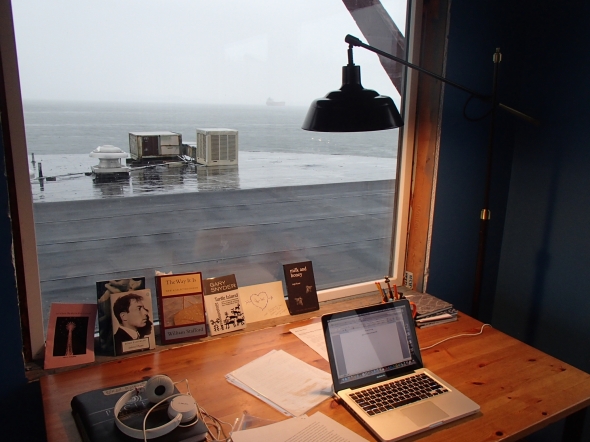A Month of Giveaways!

November is a month of book giveaways! First, I’ll be giving away 20 (yes, 20) signed copies of The Sower Comes, book three in my award-winning Solas Beir Trilogy. This is a fantasy series filled with adventure, magic, and romance. Head over to Goodreads by November 21 to enter.


Next, I’m giving away a signed copy of my newest book, Pitcher Plant. This suspense novel is set on the Oregon coast and features murder and restless spirits. It was inspired by a delightfully creepy fixer-upper I almost bought, near the beach in Seaside. To enter the giveaway, like my Facebook author page, or, if you’ve already done that, comment below. This giveaway ends November 28.
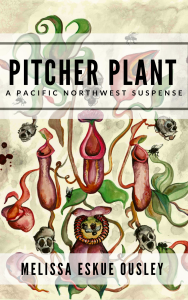
Finally, I’m giving away a signed copy of Sunset Empire, which is set in Astoria, Oregon. This novel blends history with fantasy and adds a twist to local monster legends. There’s a ghost in this one too. To enter the giveaway, follow my Twitter account (or, if you’ve already done that, comment below). This giveaway ends November 28 as well.

Best of luck!
© Melissa Eskue Ousley 2017
Pitcher Plant Release Day!

Release Day for Pitcher Plant is finally here! Come help us celebrate launch day at our release day party on Facebook. Stop by from 6-10pm EDT, and enter to win a ton of amazing prizes from Filles Vertes Publishing and yours truly, including signed books, a Seaside-themed gift pack, a $10 Amazon gift card, manuscript critiques (for those of you who have novels in progress), and more. Wondering where to get your copy of Pitcher Plant? Click right here to get it from FVP. It’s also available on Amazon in paperback and as an eBook.
I have three things to share with you today–a Q&A about the book, an excerpt, and a nifty bookmark that you can print and put into service. Enjoy!
(Tip for printing the bookmark: right click on the image, click “copy image”, and then paste it into a Word document. Tada! Your bookmark is ready to print.)
Q&A:
Q: Pitcher Plant is about a couple who buy a house on the Oregon coast, intending to fix it up, only to find out it is haunted and may be connected to a killer. What inspired the story?
A: It was inspired by a real house I visited when my husband and I were house hunting. It was a cool old house, and as we toured the property, I wondered what had happened to the people who lived there before. Of course, being a horror fan, my mind took a dark turn. It wasn’t much of a leap after seeing the spooky basement and a dead rat in the kitchen sink.
We’ve done renovations on houses before, so it was also easy to imagine a couple restoring the house. What I didn’t know, between house repairs and forensics (like how fast bodies decompose in various environments), I researched. My browser history is pretty scary. I’m not planning on killing anyone, I swear.
Q: Plotter or pantser?
A: Given that there’s a mystery in Pitcher Plant, I had to know who my villains were and plant clues along the way. But it’s also a suspense novel, and writing by the seat of my pants works well for creating unexpected twists, especially those that blur the line between the supernatural and the psychological. When I write, I usually start out with a basic idea of how the story will go, and then let my characters drive the action. I find the stories are more genuine that way, rather than adhering to a strict plot. It also helps to ground a story with realistic details that provide a sense of authenticity.
I also wrote from first-person limited, which is conducive to a suspense novel because readers only know what the main character knows and experiences. The plot unfolds for the protagonist and readers at the same time.
Q: Pitcher Plant is your fifth book. What else have you written?
A: Earlier this year I released Sunset Empire, a young adult fantasy set in Astoria, Oregon, which is close to Seaside, where Pitcher Plant is set. (If you like the Pacific Northwest, these books will certainly give you a tour of the north coast of Oregon.) The book debuted in the best selling Secrets and Shadows boxed set. Sunset Empire blends local lore and history with a paranormal twist. There’s a ghost in that one too, lurking in the tunnels under Astoria’s streets.
The supernatural is definitely a theme in my books. I also wrote The Solas Beir Trilogy, a young adult series which plays on boogeyman myths, combining legends in a contemporary fantasy with magic, old Spanish Colonial mansions, and parallel worlds.
Q: What are you working on now?
A: I’m collaborating with a friend on a novel about a small town on the Oregon coast that comes under siege by an extremist group after a natural disaster. It’s my first time writing fiction with someone, so that’s been a fun challenge. I look forward to focusing on that this summer.
Q: Who are your favorite authors?
A: I just finished reading a great book by Hester Young called The Shimmering Road. It’s the sequel to her Southern Gothic, The Gates of Evangeline. I loved the characters, twists, and supernatural elements. I also like Jim Butcher, Neil Gaiman, Christopher Moore, Terry Brooks, Kendare Blake, Chelsea Cain, and many other fantasy and horror authors. Stephen King is my absolute favorite. I’ve been reading his work since middle school, and he’s had a tremendous influence on my writing.
I also love horror movies, and they have taught me a lot about pacing and suspense. Some favorites are Pan’s Labyrinth and The Cabin in the Woods. Guillermo del Toro and Joss Whedon are masterful story-tellers.
Q: Horror and ghosts are a theme here. Have you ever seen a ghost?
A: Yup. Several years ago, my husband and I lived in a house where a number of things happened that we couldn’t explain rationally. It was a plain ranch house built in the 80s—not what comes to mind when you think haunted house. One night, I stayed up writing and my husband went to bed. I was sitting at the dining table, working on my laptop. The house had an open floor plan connecting the living room to the dining area, and the combined room and hallway were well-lit—nothing creepy about the interior of the house.
It was late—probably close to midnight—when, out of the corner of my eye, I saw a tall man standing in the hallway. At first, I thought my husband had woken up and come out of our bedroom to remind me to go to bed, so I wouldn’t be exhausted for work the next day. I turned my head and saw a black, shadowy figure, with no distinguishing features other than a sense I had that the thing was male and not friendly. We watched each other for a few seconds, and then the shadow man disappeared. I was more shocked than scared, and felt like I shouldn’t acknowledge what I’d just seen, because doing so would give it power. So, I turned back to my laptop and kept writing. I never saw the thing again, but I sometimes had the sense of being watched. I was glad when we moved out of that house.
I do love ghost stories though, and I’m always game for hearing them. And I don’t think all ghosts are malicious—I’ve heard some great stories about benevolent ghosts. My grandma once told me she lived with the ghost of an old woman and the ghost would repair things around the house, like sewing buttons back on to clothing. I don’t know if that’s a true story, but it’s a cool idea.
I think that’s why I’m attracted to writing about the supernatural. I don’t know if ghosts or cryptozoids are real, but I like the idea that they exist, the sense of possibility that even though we’ve discovered so much about our world, there are still mysteries to be solved.

Excerpt:
In the middle of the night, I woke to the sound of someone singing. After Mark’s rough day, I didn’t dare disturb him. I got up and quietly pulled the door shut behind me as I left our bedroom. Sara’s bedside lamp was on. I went in her room to find her sitting on the floor next to her doll, singing and coloring. “Sara, honey? What’re you doing?”
She looked up at me. “Playing with Tara.”
I didn’t realize she’d named her doll. “Well, it’s two in the morning. You and Tara need to go back to bed.” I felt grumpy about having to leave the warmth of my bed to tell her that, but I tried to temper my annoyance. “There’s school tomorrow, sweetie.”
She nodded, and started picking up her crayons. I knelt down to help her. The drawing was of her and another little girl, holding hands. The girl had hair in braids. “Aw, were you drawing a picture of you and Sophie?”
Sara shook her head. “No. That’s Tara. She comes to play with me at night.”
A chill ran down my spine, though I wasn’t sure why—not right then. I tucked my daughter and her doll back in bed, and gave Sara a kiss on her forehead.
I moved to turn off the lamp when Sara whispered, “Tara wants a goodnight kiss too.” I smiled and kissed the doll’s forehead. Then Sara said, “No, not the doll, Mom. Tara.”
I stared at her, puzzled. It occurred to me Tara might be the name of an imaginary friend. It wouldn’t be the first time Sara had one. “Okay…where’s Tara?”
“Don’t be silly, Mom. She’s right here.” Sara patted the place next to her—there was a slight indentation on the pillow next to her head. “Can’t you see her?”
I shook my head. “I’m sorry, honey. I can’t.” Sara’s brow furrowed in disappointment, so I added, “How ‘bout I blow her a kiss? Think that would be okay?”
Sara smiled, nodding. I puckered up, kissed my own hand, and blew it at the spot next to my daughter. Then I turned off the light. “Sweet dreams.”
“Sweet dreams, Mama,” Sara said. I couldn’t see her in the dark, but the blankets rustled as she burrowed into them.
It wasn’t until I was back in my own bed that I remembered the photo we’d found before we moved in. The little girl who’d lived here before—Tara.
Thanks for reading!
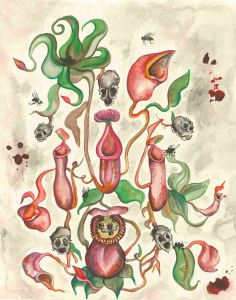
© Melissa Eskue Ousley 2017
Pitcher Plant Cover Reveal!
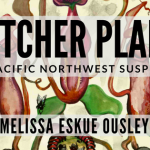
It’s cover reveal day for Pitcher Plant!
I love, love, LOVE this gorgeous cover from Filles Vertes Publishing. They are a wonderful publishing team.

Pitcher Plant
noun
a plant (especially family Sarraceniaceae, the pitcher-plant family) with pitcher-shaped leaves in which insects are trapped and digested by means of a fluid secreted by the leaves
Pitcher plants are carnivorous plants and are used throughout the book as a metaphor to represent the idea of being lured into a situation you thought would be good, but is actually a trap. Like buying a charming old house with the idea of renovating it, only to realize it’s a money pit. Or falling in love with the wrong person.
For the cover of Pitcher Plant, we were thinking about Victorian curiosity cabinets, and how they were both sophisticated and macbre in displaying botanicals like carnivorous plants, insects pinned under glass, and taxidermy. That was our guiding vision, and I think we pulled it off with a cover that is both elegant and subtly creepy. I’m proud to work with FVP, and so grateful for their hard work on this book. You can preorder it here.
I hope you’ll celebrate our launch day on May 12 by joining us at our release day party on Facebook. Stop by from 6-10pm EDT, and enter to win all kinds of amazing prizes, including a signed copy of Pitcher Plant, a Seaside-themed gift pack, a $10 Amazon gift card, manuscript critiques (for those of you who have novels in progress), and more.
In the meantime, let me whet your appetite with a description and an excerpt from the book.
Description:
When Tawny Ellis spots a fixer-upper on the Oregon coast, she and her husband jump at the chance to own a cottage near the beach. But as expensive repairs turn their dream home into a nightmare, their marriage unravels. And worse…the house is not quite vacant. Something in the house’s dark past remains.
Tawny’s daughter has a new imaginary friend, and she bears a striking resemblance to a little girl who squatted in the cottage with her drug-addicted mother. After breaking in and camping out, they vanished, and have been missing for years.
Now the house’s previous owner is enraged with Tawny. As he stalks her family, Tawny suspects she knows what happened to the last people who slept in the house. Her family might be next.
Excerpt:
I was falling in love with this fixer-upper, but before we made an offer on the house, I had to check out the basement. I clicked on the light and stepped over the threshold, into darkness. Floating dust motes filled the air, dancing in the flashlight’s beam.
The room before me was expansive, running the length and width of the house. On one end was a wooden stall for firewood, still stacked with logs. They’d come in handy if we restored the fireplace, though I didn’t look forward to cleaning off the cobwebs covering them. The other end of the basement was stacked with junk and garbage, similar to what we’d encountered upstairs.
Everything was blanketed with a thick layer of dust. My nose was stuffy—all the dust triggering my allergies. I made a mental note to take an antihistamine when I got back to the car. Otherwise I’d be paying for this excursion tonight, when my sinuses were too clogged to let me sleep. I just hoped there wasn’t any mold down here. I’d heard horror stories from my neighbor about getting mold removed from her home. The procedure had been costly, and if we got this house, it’d cost us enough as it was.
I ventured a little deeper into the basement, shining my flashlight on the pile of junk. I could make out an old wooden trunk. Did that come with the house? Maybe I’d clean it up and use it for a coffee table.
The beam of my flashlight fell on a tattered ragdoll. The doll’s fabric face and its light brown yarn hair looked dingy. Its flower print dress was dotted with rust colored stains and black flecks. The flecks looked like rodent feces.
There was a rustle to my right, and I startled, swinging my light toward the sound. Given the state of the doll’s dress, I thought it might be a rat.
Suddenly the air was thick with flies. I clamped my mouth shut as they flew toward my face, waving my arms madly to keep them away. They crawled in my hair and buzzed in my ears, and I bit back a shriek. The beam of my flashlight flickered as I used it to swat the flies. I shuddered at the thought of it going out and having to find my way back to the stairs in the dark.
I stumbled back toward the corridor that led to the door of the basement, trying to see through squinted eyes, the cloud of flies, and the dying light of the Maglite. As I reached the passage, the buzzing sound eased, and the flies began to drift back to whatever attracted them to the basement.
I dared one last look, directing my beam to the offending corner of the basement. The dirt floor was carpeted with insects. Flies and other crawling things, though I was too far away to tell what they were. There seemed to be a small lump on the floor that attracted their interest. A dead rat, most likely, but there was no way I was going back to find out.

© Melissa Eskue Ousley 2017
Worthy Causes

My new suspense novel, Pitcher Plant, launches in two short weeks! I’m excited about the May 12 book release, of course, but I’m also happy that the launch will coincide with opportunities to support two very worthy causes in my community.
The first is Write on Seaside, a fundraiser for the Seaside Public Library Foundation. As a reader and a writer, literacy is important to me. Libraries promote literacy and are the heart of our communities, a place where people learn and connect. The Seaside Public Library is a jewel in our small, coastal town, serving youth through early reading programs, after school activities, and summer reading campaigns. It serves adults too, providing a place for community meetings, hosting monthly speakers, and assisting people in finding resources.

Write on Seaside will feature six local authors: Diana Kirk, Brian Ratty, Jim Stewart, Deb Vanasse, Nick Vasilieff, and yours truly. We’ll be writing a story live, and people will have the chance to bid on story elements and plot twists to be included in the novella. There’s a whole cast of crazy characters, so if you want to name a puking seagull after your best friend (or maybe your arch enemy), here’s your chance. There will be a silent auction and books for sale, which we’ll sign and personalize. A portion of proceeds from the auction and book sales will go to support the library foundation. It should be a fun night.

Write on Seaside will be held on Thursday, May 11, at the Seaside Convention Center in Seaside, Oregon. The Author Meet & Greet is at 6:30pm, and the Writing Extravaganza begins at 7:00pm. If you’re local to the northern Oregon coast, I hope you’ll join me.
The other cause I’m supporting is the Lives in Transition Program at Clatsop Community College. The LIT Program promotes a supportive academic environment that assists students in overcoming barriers while achieving their personal and educational goals. It is comprised of two free college classes designed to promote academic success.
With a background in higher education, I understand how critical programs like Lives in Transition are in supporting students. I currently work as an academic advisor, and I’m committed to helping people obtain their education. One way I can do that is by investing in this program, and by encouraging others to do so as well.
For every book sold during release week (May 12-19), including preorders, I will donate $1 (up to $500) to the LIT Program. If you are planning on buying Pitcher Plant, would you consider preordering or purchasing it during release week? You’ll be making a huge difference in the lives of these students. I would appreciate it, and I know the students will too.
Thanks for your support of these wonderful programs, and stay tuned for more news on Pitcher Plant. We’ll be revealing the cover later this week!
© Melissa Eskue Ousley 2017
Beach Town
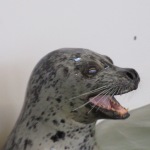

One reason I decided to set Pitcher Plant, my new suspense novel, in Seaside is because I adore this little beach town. The Oregon coast is gorgeous, and Seaside is a city with a lot of charm. It’s no wonder we get an influx of tourists when the sun comes out.

Seaside has almost two miles of beach, starting at the Necanicum Estuary, where wild elk like to forage, and stretching to the Cove, a popular surfing spot. Bordering the beach is the Promenade (or the Prom, as locals call it). You can walk the Prom, rent a surrey to bicycle through town, or cruise the Necanicum River in a paddle boat shaped like a swan.

One of my favorite places on the Prom is the Seaside Aquarium, a spot I mention in the book. The aquarium opened in 1937 and is best known for its seals. For a few dollars, you can purchase a cardboard tray of fish to toss to the seals. It’s quite an event. Each seal has their own way of getting your attention, from slapping their bellies to splashing unsuspecting tourists.

I also love the touch tanks, where you can get a closer look at the organisms in our tidepools—sea stars, crabs, sand dollars, anemone, and sea cucumbers. The aquarium does a great job displaying local wildlife, from wolf eels to small sharks.
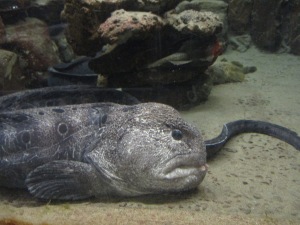
My absolute favorite creature is the giant pacific octopus, hanging out in the center of the aquarium. There’s no lid on her tank, so you can have a close encounter, staring into her intelligent eyes. I’ve often wondered, once the tourists leave for the night, does she ever leave the pool and go exploring?

© Melissa Eskue Ousley 2017
In Praise of Editors
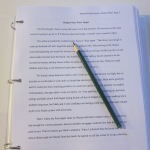
The launch date for Pitcher Plant is rapidly approaching, and the team at Filles Vertes Publishing has been hard at work behind the scenes. We’ll have a cover soon, and I can’t wait to show you all. We’re currently working on final edits, and it’s been a great experience. I truly believe the book will be stronger for having feedback from an editor and multiple proofreaders.

As a writer, there comes a point in the process of writing and revision where you can no longer see your mistakes. You know the story inside and out, so you can’t see the plot holes or the need for more character development. You can’t even see when whole words are missing. You’ve read the material so much that your mind fills in the missing parts.
It’s so important to get a fresh perspective from someone who is not as familiar with the manuscript, who can spot errors. You can use spellcheck, of course, but it doesn’t catch everything. It’s easy to spell a word correctly and use the wrong word, like there versus their or your versus you’re. Editors help with other grammatical issues too, like lay versus lie. That’s one that trips me up. Whether I’m working as a writer or editor, I always have to look it up to make sure it’s correct.
You need an editor for the big issues too, like plot and the pace of the story. I know what I want to say, but am I communicating clearly? Editors can help develop a story, fleshing out the parts that seem thin, engaging readers emotionally. They can also help you with logic, consistency, and mapping out the physical movements of your characters. A great scene can be spoiled by a mistake that pulls the reader out of the story. An experienced editor looks at a story holistically and also has an eye for detail.
Essentially, an editor helps you make a story as bullet-proof as possible. I’m grateful to have that help with this new book. We release Pitcher Plant in May, and I’m so excited for you to read it. I learned a lot about the craft in the process of writing it, and I’d like to think it’s my best novel yet.
© Melissa Eskue Ousley 2017
Literacy & Little Free Libraries

Last evening, I had the pleasure of attending a fundraiser to support a literacy program. The Libraries ROCC program is a partnership between three of our local libraries. It promotes reading outreach by providing every child in the county with a library card. As a writer, encouraging people to read is a cause near and dear to my heart, so I’m thrilled this program exists.
Libraries are so important to our communities. They foster literacy for beginning readers, give kids a safe place to hang out after school, host speakers on various educational topics, grant space for community groups to meet, and provide internet access for many patrons who don’t have it, like those with low income or who are seeking a job. One of my favorite librarians (and a beloved friend) works at the Seaside Public Library and does an outstanding job working with youth. My own children have benefitted from the wonderful summer reading program she has developed.
Beyond all that, libraries are simply sacred to me. They always have been, from the time I was old enough to have a library card. Stephen King has said that books are uniquely portable magic, and I believe this to be true. I remember visiting the library as a kid and browsing the stacks. I felt a sense of awe at the possibilities as I read the spine of each book, trying to choose just one or two to take home. Nothing has made me prouder as a parent than seeing my children fall in love with books. Seems like we’re at the library every week, feeding our addiction. It’s a pretty great addiction to have, although my to-be-read pile at home suffers every time I get distracted by a shiny new book. My boys tell me I’m only allowed to check out one book at a time. Choosing is still hard.
All these reasons are why it’s an easy decision to pull out my wallet and support programs like Libraries ROCC. It’s even easier when there’s an auction for little free libraries created by local artists. My favorite was the nautical-themed library designed by the talented folks at Vintage Hardware. (Everything Becky Johnson and her staff create is amazing, and they are constantly involved in community projects.)

The other libraries were gorgeous too. One was constructed of cedar and smelled just as wonderful as you think it would. Another was Oregon-themed, complete with a wood cut-out of the state. One had been painted with literary quotes.


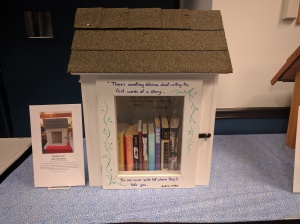
I got outbid and didn’t come home with a library, but it was great to see them going for as much as $450 and to know they’d be well-loved and curated by individuals and business owners. The most heart-warming part of the auction involved a barn-themed library. A pair of tween girls feel in love with it and started a bidding war with some of the older attendees. I was worried as the bidding got higher that they’d get in trouble for raising their bid, but the adult with them seemed okay with the amount they pledged. Finally, they got the highest bid, and were so joyful, everyone applauded and cheered. I can’t imagine the library going to a better home than that of two enthusiastic young readers.

I did come home with a few things from the silent auction, one of them a gift certificate to Norma’s, a favorite local restaurant. Anybody want to join me for dinner?
© Melissa Eskue Ousley 2017
Words of Wisdom


I got to spend last evening with some lovely, lovely writers at a book event at the Blue Scorcher Bakery. (I highly recommend the Scorcher’s hot chocolate, by the way. So rich and creamy. Their shortbread and pizza are also amazing.) We had a great group of authors, offering something for every reader: Matt Crichton, Heather Douglas, Kestrel Gates, Andrea Larson Perez, Angela Sidlo, Deb Vanasse, and me. That’s one of the best things about attending these kinds of events—besides talking with readers—hearing from other writers about their lives and writing process.
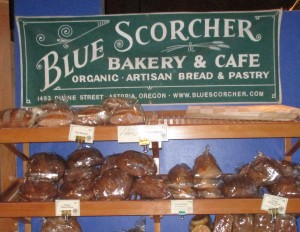
 As I went around saying hello, a couple of conversations stood out. Angela Sidlo, coauthor of the bestselling anthology, The Silver Linings Storybook: Successful Leaders Share Inspiring Stories of Overcoming Stormy Days in Personal and Professional Life, had this sage advice for aspiring writers: “Write every day, even if it’s just a series of random thoughts, and never give up!” Angela and I also talked about developing characters, and how sometimes, when you are immersed in writing, trying to see the world of the story through your character’s eyes, they almost seem to come alive. You start to visualize their universe and hear their words. That probably sounds crazy to non-writers, but in my experience, it’s true. I’ve learned to let go of my preconceived notions about how a scene should go, and let the characters drive the dialogue and action. The story is always stronger and more authentic for doing that.
As I went around saying hello, a couple of conversations stood out. Angela Sidlo, coauthor of the bestselling anthology, The Silver Linings Storybook: Successful Leaders Share Inspiring Stories of Overcoming Stormy Days in Personal and Professional Life, had this sage advice for aspiring writers: “Write every day, even if it’s just a series of random thoughts, and never give up!” Angela and I also talked about developing characters, and how sometimes, when you are immersed in writing, trying to see the world of the story through your character’s eyes, they almost seem to come alive. You start to visualize their universe and hear their words. That probably sounds crazy to non-writers, but in my experience, it’s true. I’ve learned to let go of my preconceived notions about how a scene should go, and let the characters drive the dialogue and action. The story is always stronger and more authentic for doing that.
 Another piece of advice that struck me was from Diana Kirk, author of Licking Flames: Tales of a Half-Assed Hussy. Diana’s book is a series of essays about feminism, family, travel, owning a business, and embracing sexuality. It is raw, honest, and at times inspiring, heart-breaking, and laugh out loud funny. One thing I love about Diana is she is fearless. Fortune favors the bold, and that is certainly true for her. I’ve seen her take risks in seeking out opportunities, and her courage and confidence have paid off. That’s why I love her advice for would-be authors. “Don’t be afraid of rejection,” she said. You have to put yourself out there and be vulnerable if you want to progress in your writing career. Rejection is part of the job, whether it’s submitting your manuscript to agents and publishers, asking another author to blurb your book, having your book critiqued in a review, or sitting at an event and trying to convince readers to purchase your book. It’s not easy to push fear and self-doubt aside, but you have to do it if you want to keep moving forward. Seize the day, writers.
Another piece of advice that struck me was from Diana Kirk, author of Licking Flames: Tales of a Half-Assed Hussy. Diana’s book is a series of essays about feminism, family, travel, owning a business, and embracing sexuality. It is raw, honest, and at times inspiring, heart-breaking, and laugh out loud funny. One thing I love about Diana is she is fearless. Fortune favors the bold, and that is certainly true for her. I’ve seen her take risks in seeking out opportunities, and her courage and confidence have paid off. That’s why I love her advice for would-be authors. “Don’t be afraid of rejection,” she said. You have to put yourself out there and be vulnerable if you want to progress in your writing career. Rejection is part of the job, whether it’s submitting your manuscript to agents and publishers, asking another author to blurb your book, having your book critiqued in a review, or sitting at an event and trying to convince readers to purchase your book. It’s not easy to push fear and self-doubt aside, but you have to do it if you want to keep moving forward. Seize the day, writers.
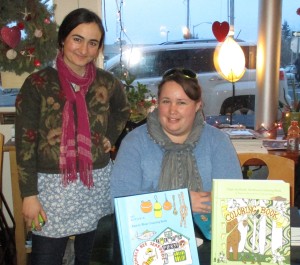
Kestrel Gates and Heather Douglas

Angela Sidlo and Andrea Larson Perez
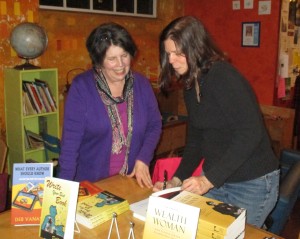
Deb Vanasse signing a book for a reader.
© Melissa Eskue Ousley 2017



